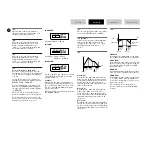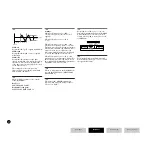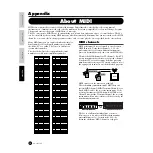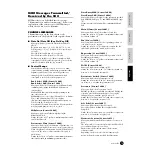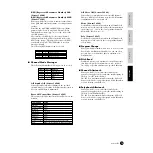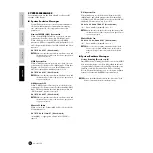
61
Basics Section
Quick Guide
Reference
Appendix
AMP (Amplitude)
23
-1
AEGAtkR
AEG Attack Rate
Determines the transition in volume (AMP) from the moment a note is pressed on the keyboard to the
point at which the sound stops. This let you reproduce many characteristics of natural acoustic
instruments – such as the quick attack and decay of percussion sounds, or the long release of a sustained
piano tone. Keep in mind that different sounds have varying degrees of natural decay. For example, a
piano sound gradually decreases in volume as you hold the key; however, an organ sound stays at the
same volume. Also, if the AEG Release Rate is set to a small value, the sustain becomes long. Refer to the
Amplitude Envelope Generator Settings (page 44).
23
-2
AEGDcy1R
AEG Decay 1 Rate
23
-3
AEGDcy2R
AEG Decay 2 Rate
23
-4
AEGRelR
AEG Release Rate
24
-1
AEGInitL
AEG Initial Level
24
-2
AEGDcy1L
AEG Decay 1 Level
24
-3
AEGSusL
AEG Sustain Level
25
AEGSclSens
AEG Scaling Sensitivity
Determines the sensitivity of the AEG Rate settings (the speed of the AEG change) to note position.
*6
26
-1
AEGLvlVel
AEG Level Velocity Sensitivity
Determines the sensitivity of the AEG Level, or the width of the AEG(volume) change to velocity.
*7
26
-2
AEGAtkVel
AEG Attack Rate Velocity Sensitivity
Determines the sensitivity of the AEG Attack Rate to velocity.
*7
27
LvlSclFlag
Level Scaling Flag
Determines the Amplitude (level) Scaling type, or how the volume responds to note position.
*8
28
Lvl BP1-4
Level Scaling BP1-4
Determines the Break Points (note numbers). BP1 to BP4 are automatically arranged in ascending order
across the keyboard.
*11
*12
29
Lvl Ofs1-4
Level Scaling Offset 1-4
Determines the Level Scaling Offset Levels. These Offsets are used by the Break Points (note positions).
*11
*12
30
LvlSclSens
Level Saling Sensitivity
Appropriate preset Level Scaling sensitivity curves (determining how note position affects the volume)
are available for each element. To decrease the effect, reduce this value (0: flat, or no effect).
31
KeyonDelay
Key on Delay
Determines the time (delay) between the moment you press a note on the keyboard and the point at which
the sound is played.
LFO (Low Frequency Oscillator)
32
-1
LFO Wave
LFO Wave
Determines the LFO waveform.
*12
32
-2
LFO Phase
LFO Phase Initialize
Determines whether or not the LFO is reset each time a note is pressed.
33
LFO Speed
LFO Speed
Determines the speed of the LFO waveform.
34
-1
LFO PMod
LFO Pitch modulation Depth
Determines the amount (depth) by which the LFO waveform varies (modulates) the pitch of the sound.
34
-2
LFO Fmod
LFO Filter Modulation Depth
Determines the amount (depth) by which the LFO waveform varies (modulates) the Filter Cutoff
frequency.
34
-3
LFO AMod
LFO Amplitude modulation Depth
Determines the amount (depth) by which the LFO waveform varies (modulates) the amplitude of the
sound.
*2
35
-1
PLFODelay
Pitch LFO Delay
Determines the delay time before the LFO comes into effect.
*14
*15
35
-2
PLFO Fade
Pitch LFO Fade-in Time
Determines the amount of time for the LFO effect to fade in (after the Delay time has elapsed). *15
*16
Selected
by
Selected
by
Display
Parameter Name
Explanation
Related
Page
Voice Edit (Normal) Element
























